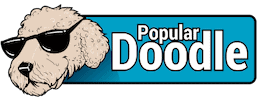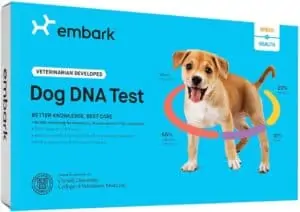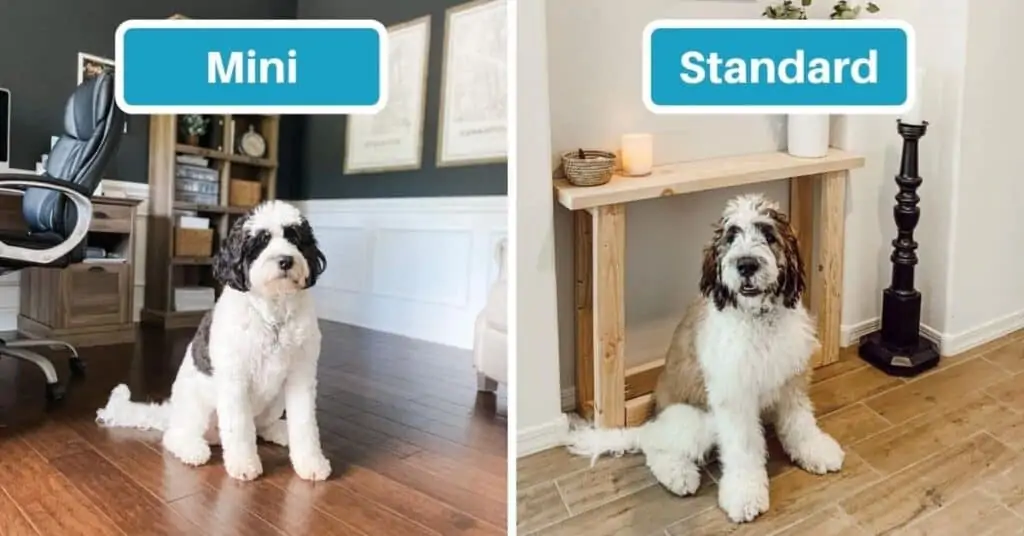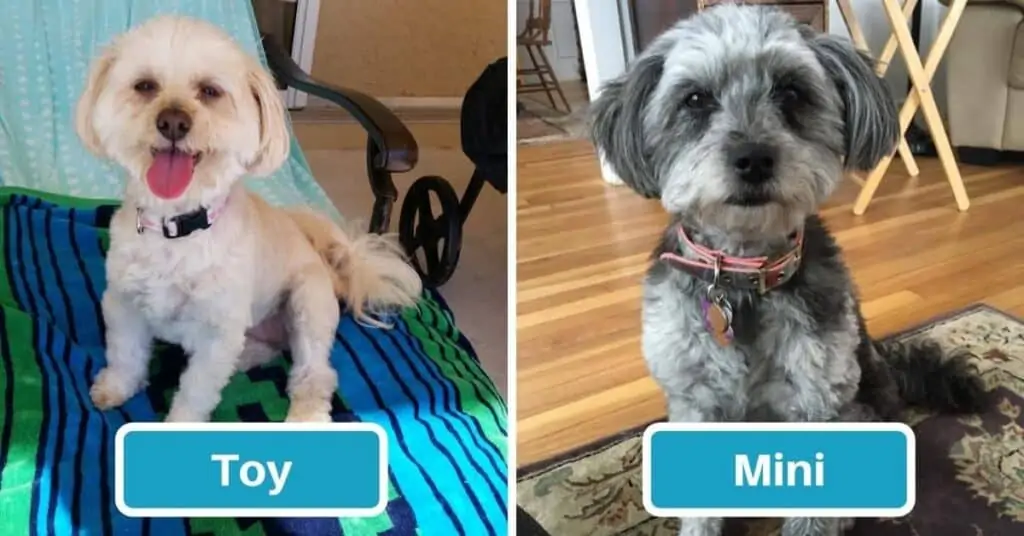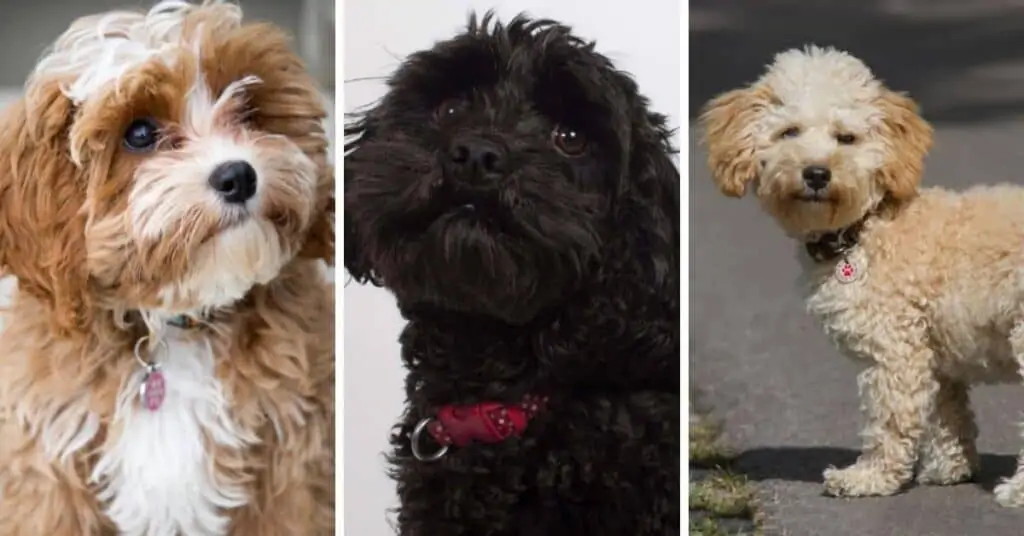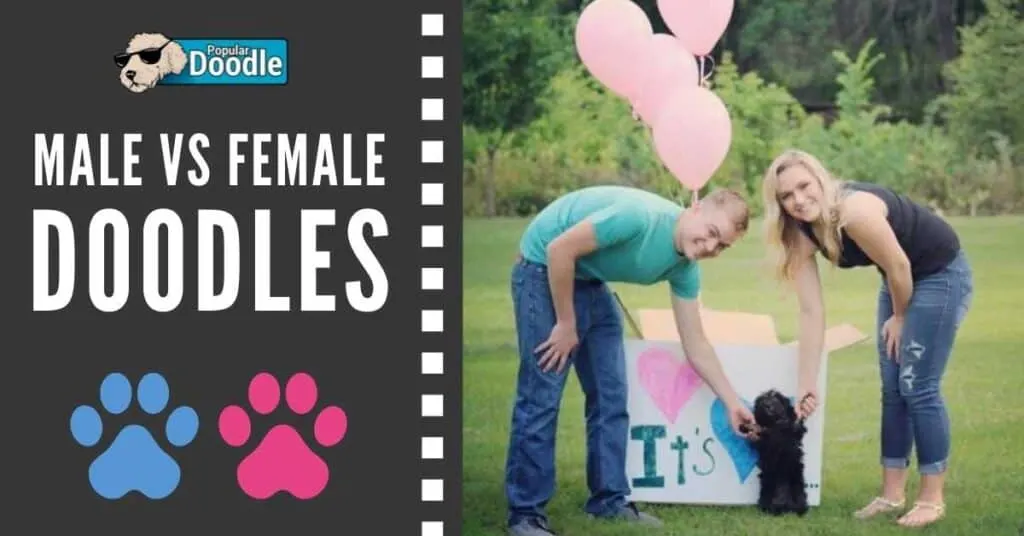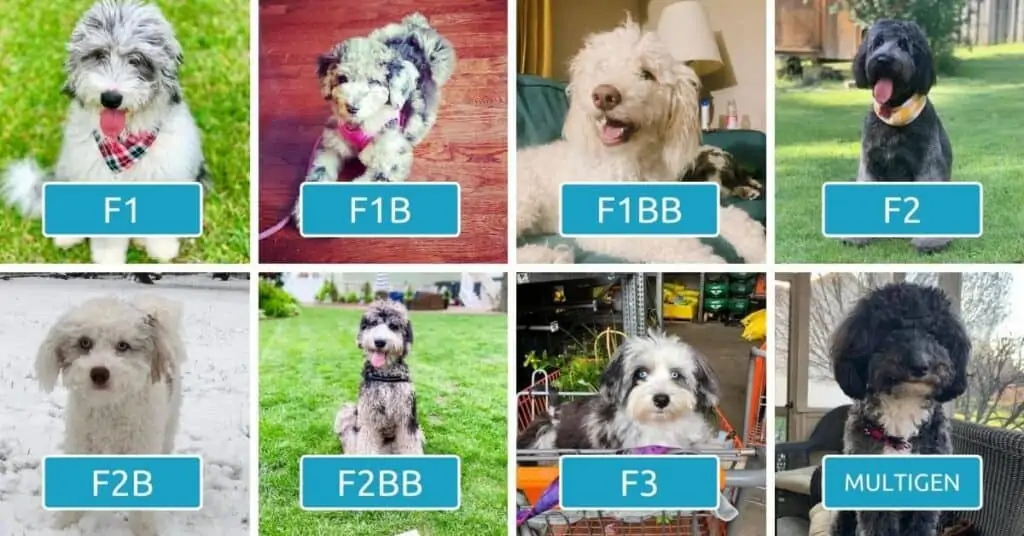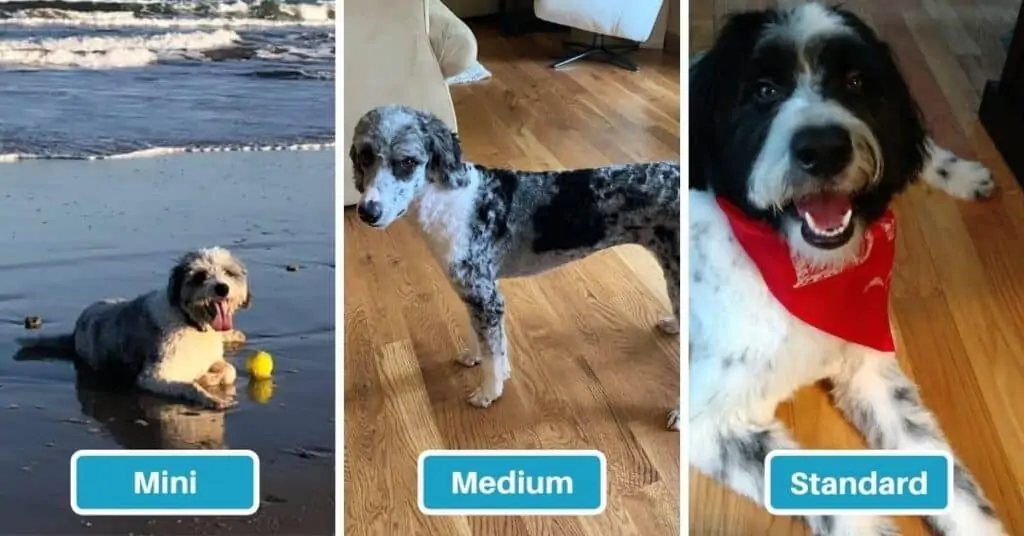
When searching for an Irish Doodle puppy, breeders will likely talk about various Irish Doodle generations. They’ll speak proudly about their “Multigen” or “F1BB” Irish Doodles, but what does that all mean anyway?
In this article, we’ll teach you everything you need to know about the various generations of Irish Doodle. Irish Doodle generations may be confusing initially, but understanding them is critical in selecting the right puppy for your family!
Crunched for time? Here’s the most essential information to know…
- Irish Doodle generations are referenced with a scientific shorthand, e.g., F1, F1B, F2, etc. These abbreviations represent your dog’s ancestry and can give us an estimate of roughly how much Irish Setter DNA vs. Poodle DNA your puppy will have.
- In general, the more Poodle DNA your Irish Doodle has, the more likely they are to be low-shedding and allergy-friendly. If this is important to you, look for Irish Doodle generations that have been backcrossed once (or more) with a purebred Poodle.
- The further the Irish Doodle generation from the parent breeds (e.g., F2, F3), the greater the genetic variability and the more challenging their traits will be to predict.
If you’re still confused, don’t worry! We’ll start with the basics and then help you decide which generation of Irish Doodle will be ideal for your family.
Understanding the Terminology of Irish Doodle Generations
Geneticists have created a set of abbreviations where a series of letters, numbers, or words refers to a larger, more complex concept.
Once we decode this shorthand, it is relatively easy to understand generations of Irish Doodles and apply it to other breeds of dogs as well.
What Does the “F” Mean in F1, F2, or F3?
The “F” that begins each generation stands for “filial hybrid.” Geneticists classify a filial hybrid as a descendant from the mating of two distinctly different parental types.
The hybrid offspring is genetically distinct from their parent breed’s genotype (i.e., genetic profile), as each parent contributed 50% of their genes to their offspring.
For example, an Irish Setter mated to another Irish Setter will NOT have filial hybrid offspring, as the offspring will have the genetic profile of an Irish Setter.
On the other hand, an Irish Setter mated to a Poodle WILL produce a filial hybrid. The Irish Doodle offspring will have a genetic profile that differs from those of the Poodle and Irish Setter parent breeds.
What Does the Number After the “F” Mean?
You’ll notice that when labeling Irish Doodle generations, the letter “F” is always followed by a number: 1, 2, or 3.
These numbers represent which generation the Irish Doodle belongs to. In other words, it describes the generational distance from the original, purebred parent breeds.
When two different purebred dogs, like the Irish Setter and Poodle, are mated together, their offspring will be F1 Irish Doodle puppies. If two F1 Irish Doodles are mated together, the offspring are F2 Irish Doodles. If two F2 Irish Doodles are bred together, the offspring will be F3 Irish Doodles, and so on.
In human terms, the F1 Irish doodles would be the sons and daughters, F2 the grandchildren, and F3 the great-grandchildren of the original parents.
What Does the “B” in F1B Or F1BB Mean?
When a “B” is included in an Irish Doodle generation, it refers to an Irish Doodle that has been “back bred” or “backcrossed” to a purebred Irish Setter or Poodle.
For example, an F1B Irish Doodle is the result of an F1 Irish Doodle being mated to a purebred Poodle or a purebred Irish Setter. Similarly, an F2B Irish Doodle is the product of an F2 Irish Doodle being bred to a Poodle or Irish Setter.
If two “B’s” are included, it means that the Irish Doodle is the product of two backcrosses to a purebred Irish Setter or Poodle. For example, an F1BB Irish Doodle means that an F1B Irish Doodle was bred back to a Poodle or Irish Setter.
Irish Doodle breeders rarely backcross to an Irish Setter, preferring to focus on Poodle back breeding. Irish Doodle puppies with more Poodle DNA tend to be more desirable because many customers prioritize finding an allergy-friendly, low-shedding dog.
Irish Doodle Generations Chart
For those like myself who are more visual learners, I created a visual aid to help you see the similarities and differences between many of the common Irish Doodle generations.

If I’m Not Breeding My Irish Doodle Puppy, Why Do Genetics Matter?
You may be wondering why the generation and, by implication, genetics of your Irish Doodle matter. After all, if they’re only a pet, isn’t it a bit of overkill to go into all this detail?
Your Irish Doodle’s genetic makeup is directly linked to their health, behavior, conformation, and coat type. Thus, every Irish Doodle owner should understand the generational genotype of their Irish Doodle.
Related: Irish Doodle Size Full Grown: How Big Do Irish Doodles Get? (Mini & Standard)
Understanding the Principles of Inheritance in Irish Doodles
This section can get a bit technical as it briefly explains how genetics work. While some may find these details interesting, most owners don’t need to worry about them unless they’re planning on breeding their dog in the future. Feel free to keep scrolling—we’ll look at each generation below and discuss the pros and cons!
Despite the tremendous genetic variability amongst hybrid dogs like the Irish Doodle, you can calculate the possibility of your pup inheriting specific genes using the Mendelian laws of inheritance.
Before we delve into Mendelian inheritance, we first need to clarify four terms: genotype, phenotype, heterozygous and homozygous.
Genotype refers to all the genes found in an Irish Doodle’s genetic makeup, including the recessive genes that are “silent” or hidden by a dominant gene. Phenotype refers to the physical manifestation of a gene.
Heterozygous means that the Irish Doodle only has one copy of a specific gene, whereas homozygous implies that the Irish Doodle has two copies of a particular gene.
Recessive genes only affect the Irish Doodle’s phenotype when two copies (i.e., homozygous) are present. A dominant gene will affect the Irish Doodle’s phenotype in both a heterozygous and homozygous genotype.
Punnet Squares Show Generational Irish Doodle Inheritance
The below punnet squares show the color inheritance of black and brown pigmentation in F1, F2, and F1B Irish Doodles; however, the inheritance principles can be applied to all heritable traits, including Irish Doodle health conditions.
Black (B) is caused by a dominant gene that codes for the black pigment eumelanin, whereas brown (b) is caused by a recessive gene that codes for phaeomelanin, the brown/red pigment that gives Irish Setters their red coats.
For this Mendelian inheritance exercise, we will look at three matings.
Homozygous Black (BB) Poodle x Homozygous Brown (bb) Irish Setter will produce:
- 100% Heterozygous Black (Bb) F1 Irish Doodles
| b | b | |
| B | Bb | Bb |
| B | Bb | Bb |
Heterozygous Black (Bb) F1 Irish Doodle x Heterozygous Black (Bb) F1 Irish Doodle will produce:
- 25% Homozygous Black (BB) F2 Irish Doodles
- 50% Heterozygous Black (Bb) F2 Irish Doodles
- 25% Homozygous Brown (bb) F2 Irish Doodles
| B | b | |
| B | BB | Bb |
| b | Bb | bb |
Heterozygous Black (BB) Poodle x Homozygous Brown (bb) F1 Irish Doodle will produce:
- 50% Homozygous Brown (bb) F1B Irish Doodles
- 50% Heterozygous Black (Bb) F1B Irish Doodles
| b | b | |
| B | Bb | Bb |
| b | bb | bb |
Responsible Irish Doodle Breeders Do Genetic Testing
Based on the principles of inheritance, it is easy to see why F2, F3, and backcrossed Irish Doodles are more susceptible to heritable health conditions controlled by recessive genes.
The Irish Doodle generations after the F1 generation show greater variability in color, coat, temperament, and other heritable traits. These Irish Doodles are also more vulnerable to health conditions controlled by recessive genes, e.g., progressive retinal atrophy.
The hidden nature of a recessive gene in a heterozygous genotype means that all dogs (even unaffected dogs) used in an Irish Doodle breeding program should undergo genetic testing to check if they’re carriers of undesirable genes.
Responsible Irish Doodle breeders should only breed with dogs with desirable phenotypes AND genotypes, thus ensuring that their Irish Doodle puppies don’t suffer from preventable inherited conditions.
Some owners choose to do genetic testing on their Irish Doodle as puppies or even as adults to better understand their risk of particular health issues. It’s actually quite simple to do this with mail-in, cheek-swab tests available through companies such as Embark!
What is an F1 Irish Doodle?
An F1 Irish doodle is the first generation cross between a purebred Irish Setter and a Poodle. These puppies are expected to have 50% Irish Setter DNA and 50% Poodle DNA.
F1 Irish Doodles are widely regarded as the healthiest Irish Doodle generation due to the effects of heterosis. Heterosis refers to the fact that F1 Irish Doodles are heterozygous dogs and thus free from heritable breed-specific recessive conditions.
This generation is also the most common Irish Doodle generation and, therefore, usually the least expensive.
The biggest drawback to F1 Irish Doodles is that it’s a crapshoot as to whether they’ll be allergy-friendly and low shedding. Of course, this is one of the most significant factors that draw people to Poodle-mix breeds, so many prospective Irish Doodle owners turn to backcrossed generations like the F1B or F1BB instead.
However, if you don’t suffer from allergies and love the appearance and personality of the Irish Setter, this could be the generation for you!
What is an F1B Irish Doodle?
An F1B Irish Doodle is bred by crossing an F1 Irish Doodle with a purebred Poodle. Rarely an F1 Irish Doodle will be crossed with a purebred Irish Setter. This is referred to as a “reverse F1B Irish Doodle.”
F1B Irish Doodles have a greater chance of inheriting the desired hypoallergenic Poodle coat than an F1. For that reason, it’s the Irish Doodle generation that many mild allergy sufferers opt for.
What is an F1BB Irish Doodle?
An F1BB Irish Doodle is the product of breeding an F1B Irish Doodle back to a Poodle. These Irish Doodles have more than 80% Poodle DNA and, as a result, tend to be more genetically similar to them.
Realistically, this is as close as Irish Doodles get genetically to a purebred Poodle. That’s why people with more severe allergies try to find an Irish Doodle of this generation. It is most likely to inherit the Poodle’s hypoallergenic, non-shedding coat.
The downfall is because this generation is more specialized, it sometimes costs more and is harder to find.
What is an F2 Irish Doodle?
F2 Irish Doodles are typically the result of breeding two F1 Irish Doodles together. However, there are other combinations of dogs that fall into this category as well.
- F1 Irish Doodle x F1B Irish Doodle
- F1 Irish Doodle x F2 Irish Doodle
- F1B Irish Doodle x F1B Irish Doodle
- Etc.
There is greater phenotype variability amongst F2 Irish Doodles than F1 Irish Doodles, as recessive traits can be expressed in their homozygous form.
For example, white is a recessive trait in Poodles and thus cannot be expressed in the heterozygous F1 generation. However, if two heterozygous F1 Irish Doodles are mated together, 25% of their offspring will be white F2 Irish Doodles.
The greater variability amongst F2 Irish Doodles means they are at risk for heritable recessive disorders common to both their purebred parents. In other words, the list of heritable disorders affecting F2 Irish Doodles is longer than those affecting either parent breed.
What is an F2B Irish Doodle?
The F2 Irish Doodle is the product of crossing an F2 Irish Doodle back to a purebred Poodle.
Irish Setters come in one color (i.e., red), whereas Poodles come in more than 20 colors and coat patterns. If you want a rare recessive color or pattern, looking at an F1B or F2B Irish Doodles is best.
These backcrossed Irish Doodles are more likely to inherit the colorful coat of their Poodle ancestor than an F1 or F2 Irish Doodle.
What is an F2BB Irish Doodle?
F1BB Irish Doodles are the result of mating an F1B Irish Doodle with a purebred Poodle. F2BB Irish Doodles have more than 80% Poodle DNA and display many heritable traits (e.g., color, temperament, conformation, health, etc.) seen in a purebred Poodle.
An F2BB Irish Doodle is relatively rare as most breeders believe there is little point in breeding a dog who is, in essence, a Poodle in everything but name. Breeders who disagree with that sentiment tend to favor the F1BB generation.
What is an F3 Irish Doodle?
An F3 Irish Doodle is the product of crossing an F2 Irish Doodle to either an F2, F2B, or F2BB Irish Doodle.
Like the F2 Irish Doodle, the enormous genetic variability amongst F3 Irish Doodles makes this one of the most challenging Irish Doodles generations to breed.
Most Irish Doodle breeders prefer to stay away from F3 Irish Doodles as they cannot accurately predict what characteristics their puppies will inherit from their parents.
What is a Multigen Irish Doodle?
A Multigen Irish Doodle is an Irish Doodle generation extending past the F2 generation. F3, F2B, F2BB, F4, and beyond are collectively referred to as Multigen (short for multigeneration) Irish Doodles.
Because multigen is a collective term referring to different Irish Doodles generations, the characteristics of Irish Doodle puppies advertised as “Multigen” vary widely based on the Irish Doodle’s specific breeding.
A responsible Irish Doodle breeder should be able to provide proof detailing when and how Irish Setter and Poodle DNA have been introduced into your Irish Doodle’s bloodlines.
Which Irish Doodle Generation is Right for You?
While Irish Doodle generations are complex, picking the best one for your family is relatively simple.
If someone in your family has dog allergies, opting for a generation that’s closer in DNA to a purebred Poodle enhances your odds of finding an allergy-friendly puppy. If you can’t stand shedding, the same logic applies.
Otherwise, I’d recommend an F1 Irish Doodle for its genetic versatility and ease of breeding. This tends to make for lower-cost, healthy dogs. Plus, you get to enjoy the grab-bag of traits from both the Irish Setter and Poodle!
Of course, picking a knowledgeable, reputable breeder is just as important as the generation of your future puppy—if not more! If a breeder doesn’t seem to understand how generations work or they don’t do genetic testing on all their parent dogs, those are huge red flags.
